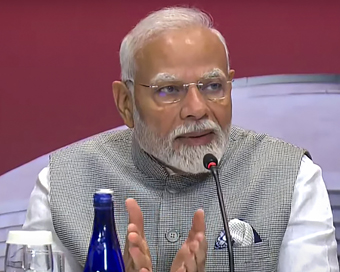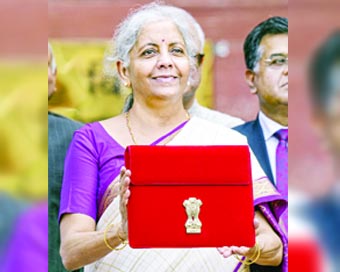 PM Modi visit USA
PM Modi visit USA Only the mirror in my washroom and phone gallery see the crazy me : Sara Khan
Only the mirror in my washroom and phone gallery see the crazy me : Sara Khan Karnataka rain fury: Photos of flooded streets, uprooted trees
Karnataka rain fury: Photos of flooded streets, uprooted trees Cannes 2022: Deepika Padukone stuns at the French Riviera in Sabyasachi outfit
Cannes 2022: Deepika Padukone stuns at the French Riviera in Sabyasachi outfit Ranbir Kapoor And Alia Bhatt's Wedding Pics - Sealed With A Kiss
Ranbir Kapoor And Alia Bhatt's Wedding Pics - Sealed With A Kiss Oscars 2022: Every Academy Award Winner
Oscars 2022: Every Academy Award Winner Shane Warne (1969-2022): Australian cricket legend's life in pictures
Shane Warne (1969-2022): Australian cricket legend's life in pictures Photos: What Russia's invasion of Ukraine looks like on the ground
Photos: What Russia's invasion of Ukraine looks like on the ground Lata Mangeshkar (1929-2022): A pictorial tribute to the 'Nightingale of India'
Lata Mangeshkar (1929-2022): A pictorial tribute to the 'Nightingale of India' PM Modi unveils 216-feet tall Statue of Equality in Hyderabad (PHOTOS)
PM Modi unveils 216-feet tall Statue of Equality in Hyderabad (PHOTOS)The Badminton Association of India (BAI) has announced a 14-member-strong India squad for
- Men’s Sr Hockey Nationals to be played in division-based format from April 4
- Mensik denies Djokovic 100th title in Miami final
- KIPG: Son of a vegetable vendor, Bihar’s Jhandu Kumar eyes Worlds, 2028 Paralympics
- Hardik Singh credits hard work and team unity for receiving HI Midfielder of the Year award
- Djokovic, Alcaraz land in same half of Miami draw
Budget boosts consumption, fiscal prudence, Capex: Report Last Updated : 03 Feb 2025 01:46:30 PM IST 
The Union Budget 2025–26 The Union Budget 2025–26 is crafted as a bold statement of fiscal consolidation and long‐term structural reforms, with the government maintaining the fiscal deficit at 4.4 per cent for FY26 while maintaining investment momentum with capital spending rising by 10 per cent to ₹11.2 lakh crore.
This is a delicate balance, ensuring credibility in debt management while not derailing growth, according to a PL Capital report released on Monday.
The government has not only provided for an increase in Capex but central schemes like PM Awas, Rural Drinking Water and solar rooftop scheme have seen sharply higher allocations than FY25RE, the report points out.
The focus on domestic manufacturing has been sustained with higher allocations under the PLI, renewable energy and the semiconductor ecosystem.
The budget has also provided relief to the middle class by lowering tax rates in the new regime with a hint of new direct tax code introduction shortly.
Continued thrust on Capex and more money in the hands of people will likely boost domestic consumption.
A notable positive for financial markets is the absence of any new taxes on equity markets, such as Securities Transaction Tax (STT) or Long-Term Capital Gains Tax (LTCG), boosting investor sentiment, according to the report.
It highlights that the budget incentivises domestic manufacturing, energy transition, and urban development while ensuring compliance-driven revenue growth without new tax burdens.
Hopes of broad-based economic recovery will support markets and provide double digit returns in CY25.
“We recommend investments in Consumers (staples and Discretionary), Travel and Tourism, EMS, Hospitals and Pharma, Capital Goods and select auto stocks,” the report stated.
The report further states that gross market borrowings of ₹14.82 lakh crore (higher than the ₹14.5 lakh crore expected by the market) along with ₹2.5 lakh crore switches, exert short-term pressure on bond yields.
However, expectations of an imminent rate cut, supportive open market operations (OMO), and upcoming RBI policy clarity should stabilise yields between 6.7-6.75 per cent, the report states.
With an outlay of ₹11.21 lakh crore (up 10 per cent YoY), the budget continues its Capex-led growth model.
Effective capital expenditure at ₹15.48 lakh crore ensures multiplier effects, particularly in infrastructure, nuclear power logistics, and energy transition.
The shift towards public-private project execution signals an effort to crowd in private capital rather than relying solely on government-led investments, the report observes.
The restructured personal income tax regime, raising the nil tax slab to ₹12 lakh and rationalising slabs, enhances disposable incomes and revives urban consumption.
Sustaining rural demand is targeted through increased Kisan Credit Card limits, direct farm support, and rural infrastructure spending, it observes.
By enhancing ease of doing business via tax certainty (new income tax code, safe harbour rules), revamping the corporate M&A framework, and liberalising FDI in insurance (100 per cent), the budget lays a road map for private sector-led Capex revival.
Monetisation of core assets via the National Monetisation Pipeline (NMP 2.0) supports this shift, the report adds.IANS New Delhi For Latest Updates Please-
Join us on
Follow us on








172.31.16.186







